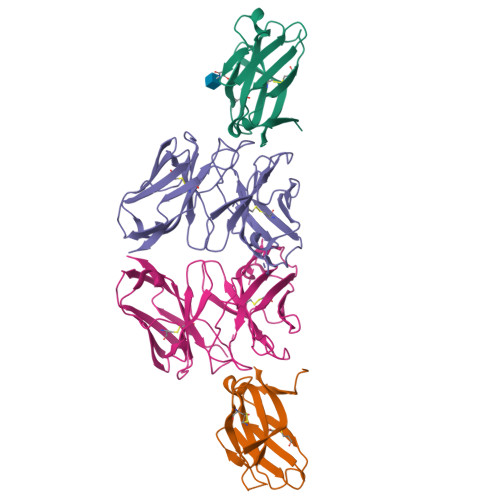Selection and structural characterization of anti-TREM2 scFvs that reduce levels of shed ectodomain.
Szykowska, A., Chen, Y., Smith, T.B., Preger, C., Yang, J., Qian, D., Mukhopadhyay, S.M., Wigren, E., Neame, S.J., Graslund, S., Persson, H., Atkinson, P.J., Di Daniel, E., Mead, E., Wang, J., Davis, J.B., Burgess-Brown, N.A., Bullock, A.N.(2021) Structure 29: 1241-1252.e5
- PubMed: 34233201
- DOI: https://doi.org/10.1016/j.str.2021.06.010
- Primary Citation of Related Structures:
6Y6C, 6YMQ, 6YYE - PubMed Abstract:
Mutations in TREM2, a receptor expressed by microglia in the brain, are associated with an increased risk of neurodegeneration, including Alzheimer's disease. Numerous studies support a role for TREM2 in sensing damaging stimuli and triggering signaling cascades necessary for neuroprotection. Despite its significant role, ligands and regulators of TREM2 activation, and the mechanisms governing TREM2-dependent responses and its cleavage from the membrane, remain poorly characterized. Here, we present phage display generated antibody single-chain variable fragments (scFvs) to human TREM2 immunoglobulin-like domain. Co-crystal structures revealed the binding of two scFvs to an epitope on the TREM2 domain distal to the putative ligand-binding site. Enhanced functional activity was observed for oligomeric scFv species, which inhibited the production of soluble TREM2 in a HEK293 cell model. We hope that detailed characterization of their epitopes and properties will facilitate the use of these renewable binders as structural and functional biology tools for TREM2 research.
Organizational Affiliation:
Centre for Medicines Discovery, Nuffield Department of Medicine, University of Oxford, Old Road Campus Research Building, Roosevelt Drive, Oxford OX3 7DQ, UK.





















